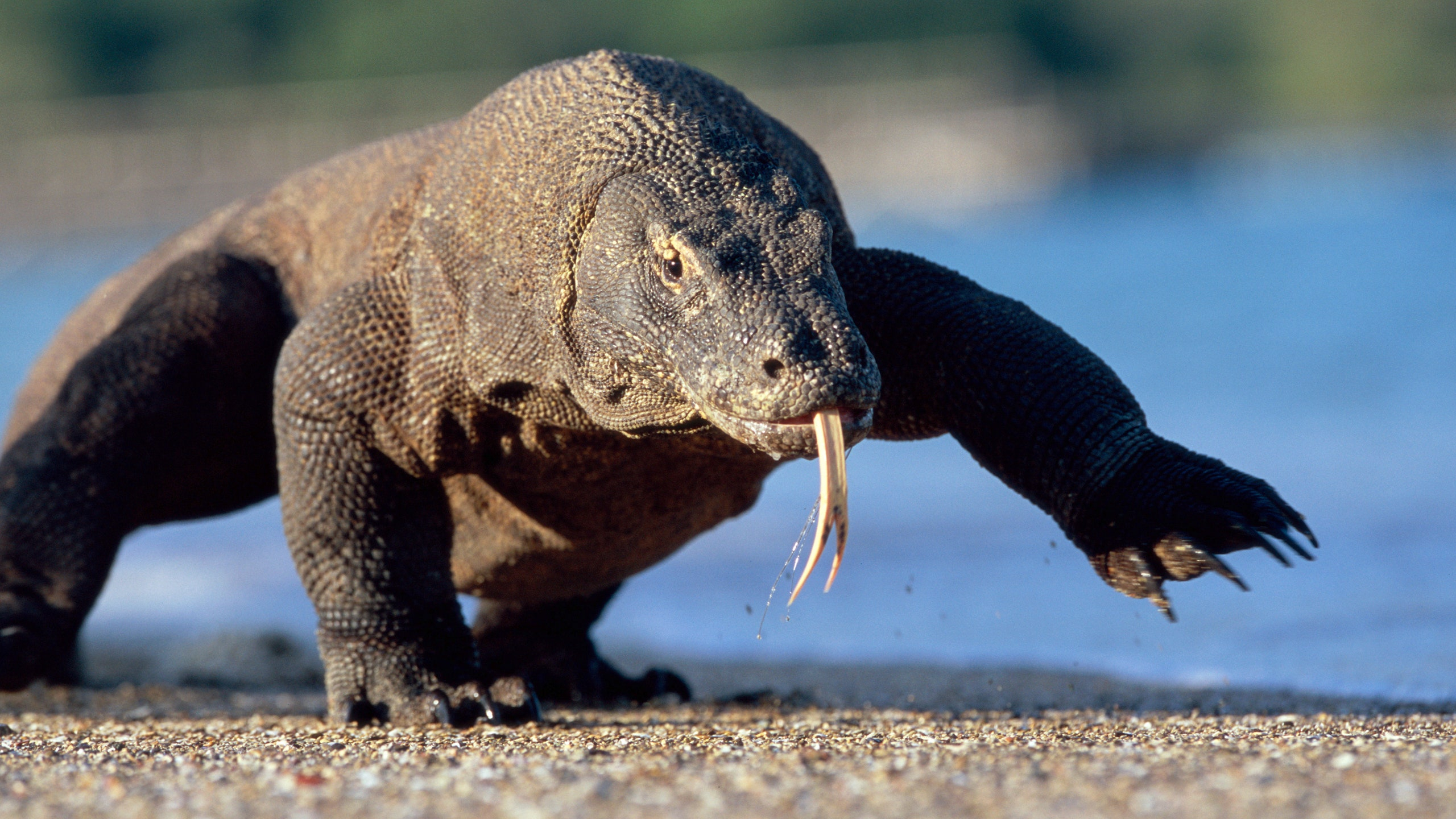
A Dragon on the Hunt
Park ranger Main had spent 25 years working with Komodo dragons in Komodo National Park, Indonesia. As he worked in his hut, he started thinking about the change in their behavior. Komodo dragons never used to attack humans, but reports of injuries and deaths had begun to pile up. The dragons had become more aggressive after the rangers stopped feeding them.It used to be common for rangers to feed the dragons dead goats. This attracted large numbers of the lizards for study and kept them away from humans on the island.
Just two years before, a Komodo dragon had killed an 8-year-old boy who was fishing with his uncle. Main was glad that his hut rested on stilts, tall posts holding the home above the ground. The dragons would never be able to climb all the way up. Or so he thought.
Main heard a faint noise on the stairs to his hut. He continued with his work, expecting a knock on the door. Instead, he felt razor-sharp teeth sink into his ankle. A Komodo dragon had climbed the stairs and crept under his desk! He could feel the dragon trying to tear his flesh from his bone. Main reached under the desk and tried to pry the deadly jaws off his leg. The dragon let go of his ankle only to sink its teeth into Main’s hand. Main screamed. He fought with the dragon and hoped someone would hear his cries for help. His friends arrived quickly. They used large sticks to drive the dragon away.
Main’s friends saw that he was badly injured. His ankle and hand were shredded and dripping with both blood and the Komodo dragon’s saliva. They had to get him to the hospital, but the nearest one was on a different island. The men piled into a boat and sped to the island of Bali. Main’s hand and ankle were extremely swollen when they got there. He was nearly unconscious, not aware of his surroundings. The doctors rushed to give him special medicine called antibiotics to fight the infection.
Deadly Lizard
The Komodo dragon is the largest lizard in the world. Its giant size and deadly reputation have made it legendary in many parts of the world. However, the Komodo dragon lives on only a few small islands in Indonesia. The dragon is a monitor, a type of lizard that has been around for more than 250 million years. Most monitors are small. However, Komodo dragons have grown large because they have few predators. They can be 10 feet (3 meters) long and weigh around 300 pounds (135 kilograms). Deer and wild boars are their favorite prey, but they can take down animals as large as water buffalo. A water buffalo can weigh eight times more than a Komodo dragon!
A Komodo dragon’s jaws can be even more terrifying than its size. It has sharp, serrated, or pointy, teeth that curve toward the back of its mouth. This shape is perfect for tearing large chunks of flesh from unlucky victims. Even more horrifying, the mouth of a Komodo dragon is full of deadly germs called bacteria. Victims of dragon bites almost never escape without a life-threatening infection.
A Komodo dragon also produces poisonous venom in organs called glands along its lower jaw. The venom oozes between the dragon’s teeth as it bites. This poison causes prey to bleed to death quickly and become too weak to fight back. The dragon can devour prey in minutes. It sinks its teeth in and shakes its head back and forth to rip off huge pieces of flesh. Then it tilts its head back to swallow. The dragon’s jaws separate so it can swallow smaller animals whole.
Komodo dragons spend most of the day on the hunt. They can run up to 11 miles (18 kilometers) per hour in short bursts. This is fast enough to catch many small animals. In order to catch larger, faster prey, the Komodo dragon must hide and wait. It flicks its forked tongue around to smell and taste the air for signs of approaching prey. The dragon senses a deer nearby. It charges at the deer with its deadly mouth open. The deer gets away, but not without a gaping wound. The dragon knows the deer will soon die from poisoning or infection. Such a tasty meal will be worth the wait.
Komodo dragons live alone from birth. Their deadliest predators are other Komodo dragons. Adult dragons often eat eggs, young dragons, or even smaller adult dragons. They are careful to avoid each other. However, adult dragons will come together to feast if they smell the rotting flesh of a dead animal. They can smell dead flesh called carrion up to 7 miles (11 kilometers) away. They flick their tongues in and out to find the kill. The largest dragons are the first to sink their teeth in. When smaller dragons arrive, they are careful not to get in the way. They sneak a few mouthfuls here and there while the large dragons stuff themselves until their bellies touch the ground.
Komodo Dragon Attacks
Komodo dragons rarely attack humans, but when they do, the attacks are often deadly, or lethal. Most attacks occur because a dragon feels threatened. Many people travel to Indonesia to see the dragons in person. Sometimes they get too close. If a person corners a Komodo dragon, the lizard will open its mouth and hiss loudly. It will lift and curl its powerful tail, preparing to strike. If the person does not back away, the dragon will charge.
Komodo dragons also attack humans who look like easy prey. A dragon will attack someone who appears to be injured. If a person falls or is lying on the ground, he or she is vulnerable, easily able to be hurt from a Komodo dragon attack. Young children are also tempting targets because of their small size and fearlessness.
Komodo dragon attacks can be prevented. People on tours should listen to their guides and never wander from their group. They should stay quiet and give the dragons space. Most tour guides carry a forked stick to keep dragons from coming within charging distance.
Many zoos across the country give visitors the opportunity to safely observe and learn about Komodo dragons without traveling to Indonesia. Learning more about these ancient lizards will help us protect them and their island homes. It will also help us better understand their behavior and how to avoid the poisonous jaws of these deadly dragons.



 About BeeLine
About BeeLine